Hazeline Snow
Stearates have been used in skin preparations from at least 1873 (deNavarre, 1975, p. 283) but are best known for their use in vanishing creams. The first commercial version of these was Hazeline Snow, introduced by Burroughs Wellcome in 1892 (The Dublin Journal of Medical Science, 1892).
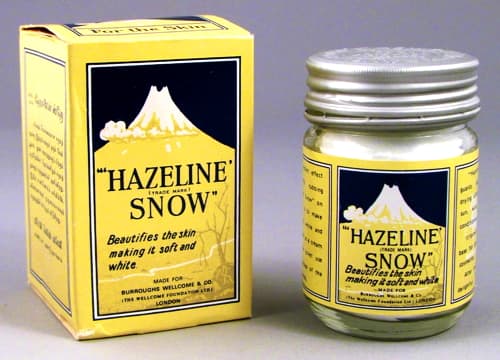
Above: Hazeline Snow. An aluminium, screw-top lid was used to avoid corrosion from the oil-in-water emulsion (Smithsonian).
See also: Vanishing Creams
Burroughs Wellcome
Established in London in 1880 by two Americans, Silas Mainville Burroughs [1846-1895] and Henry Solomon Wellcome [1853-1936], Burroughs Wellcome & Co. Ltd. supplied the pharmaceutical and medical professions with a range of standardised preparations.
The main object of ‘Wellcome’ Brand Products is to establish uniformity of content in drugs, and to eliminate variations and their first causes; in a word, STANDARDISATION. So we get back to sources, be they mineral, vegetable, animal, or their synthetic congeners; and to tests, whether chemical, optical or physiological. Moreover, the tests imposed by Burroughs Wellcome & Co. are subject to continual revision as new and improved standards of stringency are devised. ‘Wellcome’ Brand Products are, therefore, unsurpassed, and pre-eminently trustworthy.
(Burroughs Wellcome publicity material, 1912)
Silas Burroughs died from influenza in 1895 and the business then went to Henry Wellcome. Henry was interested in primary research and established a Physiological Laboratory in 1894 to develop vaccines and sera, a Chemical Research Laboratory in 1896 to produce new drugs, and a Tropical Research Laboratory in 1902. The products developed and manufactured by the firm were distributed throughout the British Empire and beyond.
Along with pharmaceutical products, Burroughs Wellcome produced a range of toiletries including cold creams, soaps and pomades made with lanolin. The company also developed a number of formulations containing witch hazel, distilled from the green leaves and twigs of the plant Hamamelis virginiana. Witch hazel is a colourless liquid, with a characteristic odour, containing about 17% of alcohol added as a preservative (Poucher, 1930, p. 173). Known in America as Winterbloom, it was used in patent medicines as an astringent (constricts tissue), a haemostatic agent or styptic (helps stop bleeding), and/or as an anodyne (pain reliever). However, later writers expressed doubts about many of these perceived properties.
Distilled extract of witch hazel (from Hamamelis virginiana), Hamamelis water, has been a popular pseudo drug with many properties attributed to it by various beauty editors and beauty experts. It is claimed to be a toning lotion in undiluted form; an astringent, coolant, anti-inflammatory, healing agent, antipruritic and endermic.
Few if any of these properties have been substantiated.(deNavarre, 1975, p. 302)
See also: Skin Tonics, Astringents and Toners
Hazeline
Burroughs Wellcome marketed its witch hazel extract as Hazeline and recommended it for a wide range of ailments.
Prescribed in cases of haemorrhage from the nose, lungs, womb, rectum, &c. Is a valuable agent in the treatment of bruises, sprains, inflammation, peritonitis, piles, fistula, anal fissure, ulcers, varicose veins, eczematous surfaces, tonsillitis pharyngitis, nasal and post-nasal catarrh, stomatitis, leucorrhoea, nasal polypi, &c.
(Burroughs Wellcome advertisement, 1891)
Burroughs Wellcome also added Hazeline to a number of other products including skin creams, soap, a dentifrice and suppositories. The skin creams came in two forms, Hazeline Cream, a cold cream containing lanolin – first produced around 1890 – and Hazeline Snow, a non-greasy stearate cream. Both creams were viewed by Burroughs Wellcome as medicinal and were included in first-aid cabinets that the company produced for sale at home and abroad.
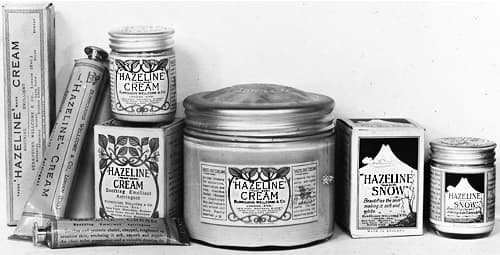
Above: 1925 Hazeline Cream (jars & tubes) and Hazeline Snow (jars).
Hazeline Cream: “An astringent and sedative emollient, presenting the valuable astringent properties of ‘Hazeline’ in combination with an emollient base of exceptional purity. This product is of very marked superiority as a toilet preparation. It allays irritation, relieves chafing, removes roughness of the skin, and is a valuable application in eczema, acne rosacea, and other skin affections. It is employed largely in the treatment of haemorrhoids; for this purpose special vulcanite nozzle is obtainable, which can be screwed on the collapsible tube in which this product is supplied.”
Hazeline Snow: “A preparation containing a high percentage of ‘Hazeline,’ adapted for application to the skin, by which it rapidly absorbed, leaving no trace of greasiness. It renders the skin soft and smooth, and removes redness and roughness.”
Composition
Hazeline snow was a soft, stearate cream with 50% of the formulation being Hazeline. It was probably made using sodium and/or ammonium bicarbonate as the alkali as these release carbon dioxide during the manufacturing process resulting in a cream with a foamy/snowy consistency. Other companies also used this method of manufacture and also sold their creams as ‘snows’ or ‘foams’.
The alcohol content of the witch hazel and the carbon dioxide bubbles produced by the carbonates were both liable to evaporate, resulting in a loss of volume, so a good screw-top jar was essential. This was made from aluminium as it did not rust. Another way to reduce evaporation was to put the cream in a tube.
[When making a witch hazel cream] a soft vanishing cream formula is used but replacing half or more of the water with witch hazel. This is added at room temperature after saponification has taken place; no further perfume is necessary, but often a compatible simple floral fragrance such as rose is also used. If any significant amount of witch hazel is used, it must be remembered that the alcohol content will slowly evaporate resulting in a contraction in volume. As a result witch hazen [sic] creams are usually put up in collapsible tubes. Although these creams are not popular in North America, they do enjoy considerable favor elsewhere.
(deNavarre, 1975, pp. 302-303)
Rust does not appear to have been the primary motivation for Burroughs Wellcome adding Hazeline Snow in tubes in 1930. It seems likely that Hazeline Cream was packaged a tube so that it could be connected to a device used to treat haemorrhoids. When the company introduced Hazeline Snow in tubes this was probably to enable women to carry it in their handbag or purse.
Although it was advertised as protecting the skin against winter winds, the product was more popular in warmer climates where it was described as being “deliciously cooling and refreshing to hot and inflamed skins as a gentle shower or rain is to sun scorched flowers”. It was also recommended for ‘prickly heat’, sunburn and inflammation caused by wind, dust and perspiration.
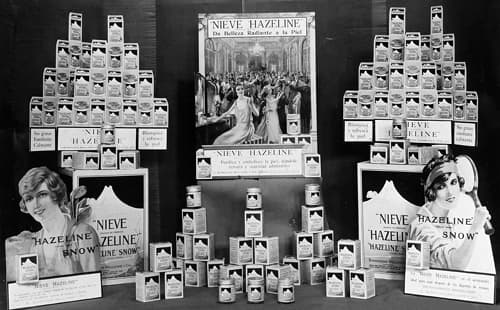
Above: 1920s South American window display for Hazeline Snow. Note the active sporting images.
On the links, in the car, at the tennis court, “Hazeline Snow” protects from the winter’s wind and the summer’s sun. At home, during an afternoon at bridge “Hazeline Snow” saves the skin from overheating and subsequent discomfort.
(Hazeline Snow brochure, 1920s)
By the 1920s, Hazeline Snow and Hazeline Cream were both being marketing as cosmetics rather than medicinals, and the phrase ‘Vanishing Cream’ was included on the label for Hazeline Snow – a term they probably appropriated from the Pond’s Extract Company.
The Pond’s Extract Company
The Pond’s Extract Company had been making Pond’s Extract, containing witch hazel, since 1846. In the twentieth century, Pond’s geared itself towards cosmetics and toiletries, introducing a stearate cream and a cold cream in 1904. Unlike Burroughs Wellcome, they sold their stearate cream as a cosmetic from day one, calling it a vanishing cream that “keeps your skin soft and moist, pliable and elastic”.
See also: Pond’s Extract Company
Burroughs Wellcome resisted calling Hazeline Snow a vanishing cream describing it as ‘better than ordinary, so-called “vanishing creams”.’ However, in the 1920s, it was adding phrases such as ‘admirable vanishing properties’ and ‘vanishes without a trace’ into its advertising copy. The company also combined Hazeline Snow and Hazeline Cream together as a day and night treatment regime in the same way that Pond’s marketed their Vanishing and Cold Creams.
See also: Day and Night Creams
Ozozo
In 1922, Burroughs Wellcome introduced a modified form of Hazeline Snow called Ozozo with added pigments to make it more like a rouge. This may have been a Western version of Hazeline Rose Frost that Burroughs Wellcome developed for the Chinese market before the First World War.
Ozozo: “A delightful toilet preparation of distinction and refinement. Possesses the virtues of ‘Hazeline Snow,’ and at the same time gives an exquisite natural colour to the cheeks. A single trial will convince you of its worth.”
The two products were sometimes advertised together with the suggestion that if Ozozo was combined with Hazeline Snow ‘any colour could be obtained’.
Later developments
Burroughs Wellcome continued to produce Hazeline Snow after the Second World War.
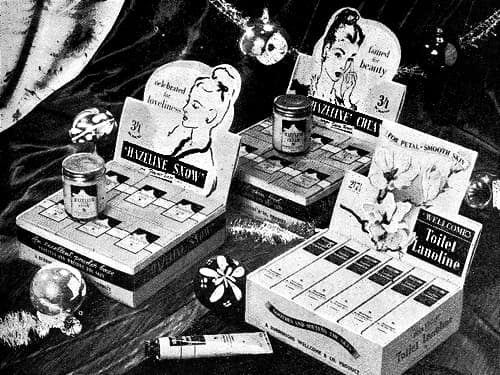
Above: 1949 Display boxes for Hazeline Snow, Hazeline Cream and Toilet Lanolin.
Sales in the West declined dramatically after the war as vanishing creams were replaced with modern foundations. The product had a stronger following in the Far East where Burroughs Wellcome had taken legal action against Japanese and Chinese companies over copyright infringements.
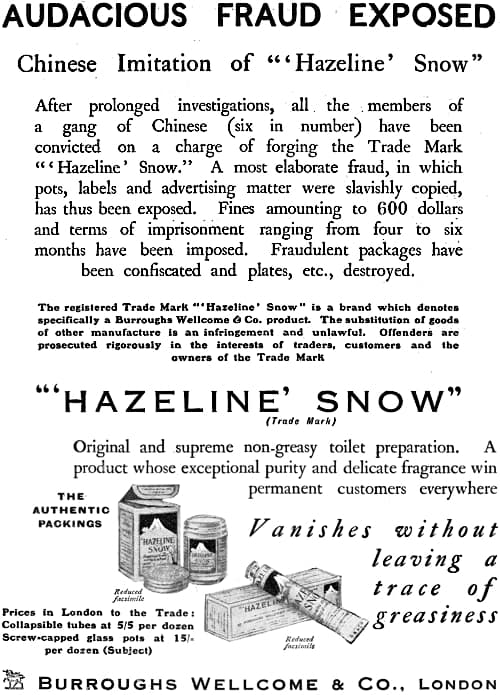
Above: 1931 Trade advertisement for Chinese trademark violation.
Burroughs Wellcome continued to make Hazeline Snow in Britain through to 1970 for export to markets in the Middle and Far East where their was still some demand.
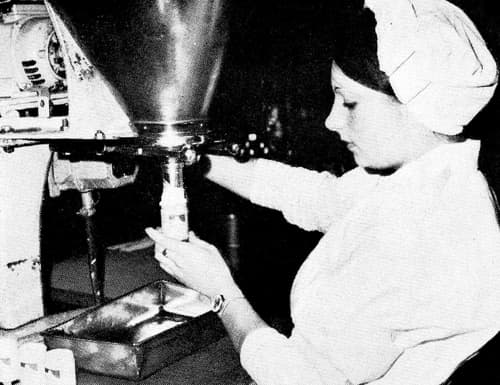
Above: 1970 The last jar of a batch of 6,000 jars of Hazeline Snow being filled at Wellcome, Dartford for export.
After Burroughs Wellcome stopped manufacturing Hazeline Snow in 1970, it continued to be made under licence by Unilever subsidiaries in the Far East until at least 2014 when they ceased production as well. Unilever China introduced three Hazeline Snow products in 2018 but none of these are using the original formulation. This means it is no longer available anywhere.
First Posted: 30th August 2010
Last Update: 24th November 2021
Sources
Burroughs Wellcome and Company. The “Hazeline” brand of the active principles distilled from the bark of witch hazel, hamamelis virginiana [Booklet]. London: Burroughs Wellcome and Co.
The chemist and druggist. (1859-) London: Morgan Brothers.
deNavarre, M. G. (1975). The chemistry and manufacture of cosmetics. (2nd. ed., Vol. III). Orlando: Continental Press.
New preparations and scientific inventions. (1892).The Dublin Journal of Medical Science, June 1, 552.
Poucher, W. A. (1932). Perfumes, cosmetics and soaps (4th ed., Vols. 1-2). London: Chapman and Hall.
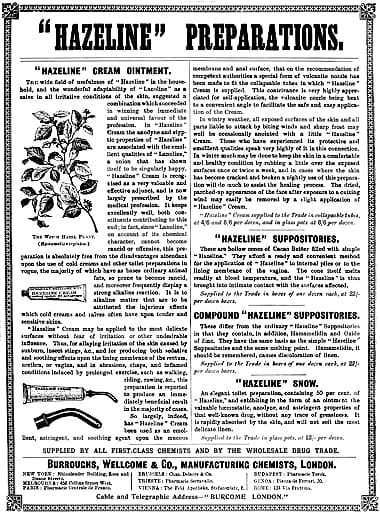
1895 Burroughs Wellcome products using Hazeline.
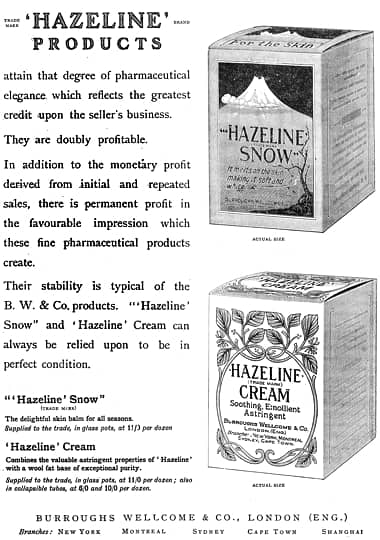
1909 Burroughs Wellcome Hazeline Snow and Hazeline Cream.
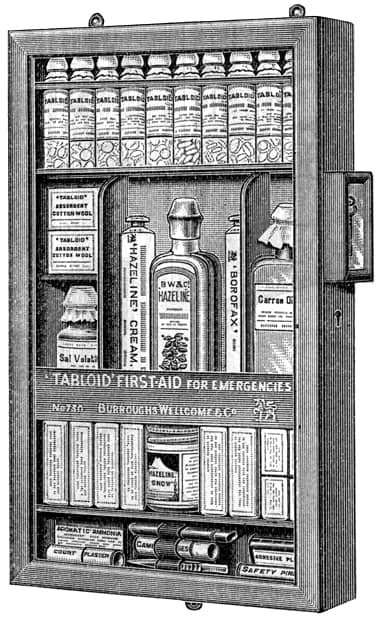
1912 Burroughs Wellcome Tabloid First-Aid Cabinet containing a bottle of Hazeline, a tube of Hazeline Cream and a jar of Hazeline Snow.

1914 Trade advertisement for Hazeline Snow.
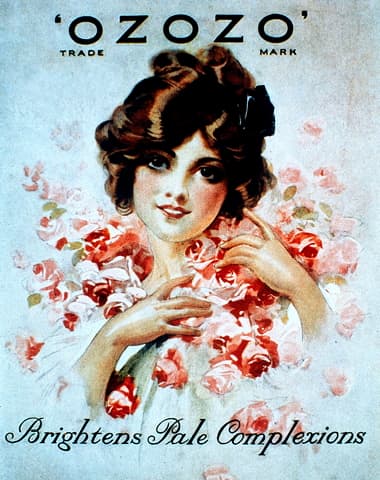
1922 Ozozo.
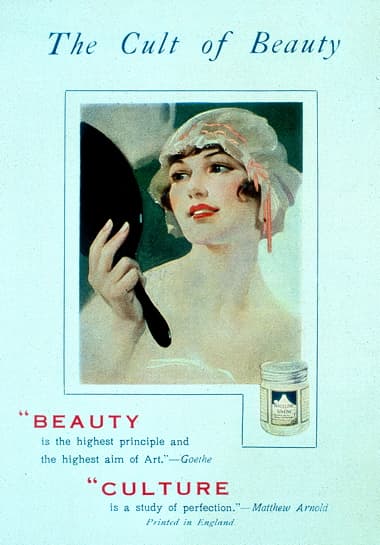
1929 Hazeline Snow.

1929 Hazeline Snow (day) and Hazeline Cream (night).
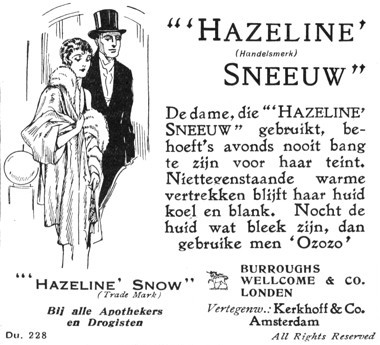
1929 Hazeline Snow (Amsterdam).
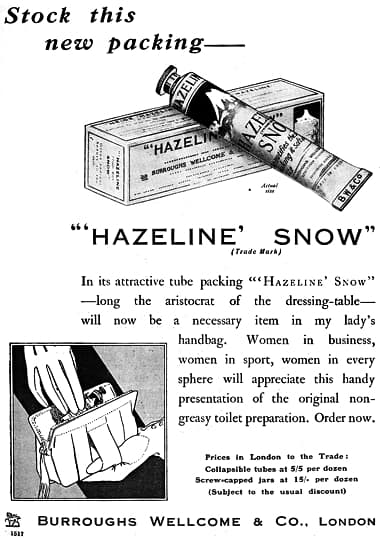
1930 Trade advertisement for Hazeline Snow, now in tubes.
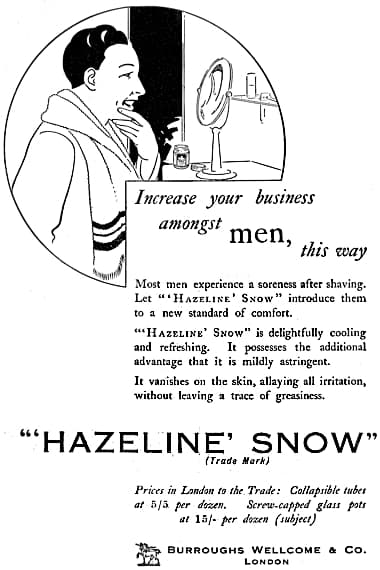
1931 Trade advertisement for Hazeline Snow recommended as an after-shave treatment.
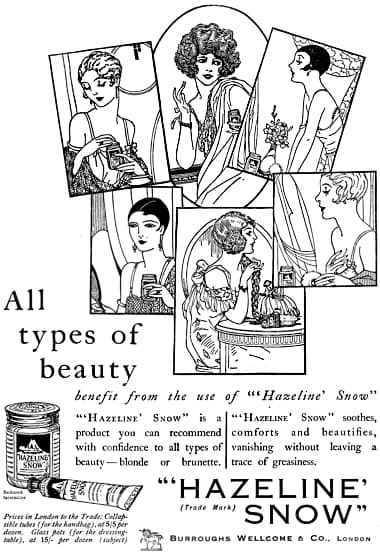
1931 Trade advertisement for Hazeline Snow.
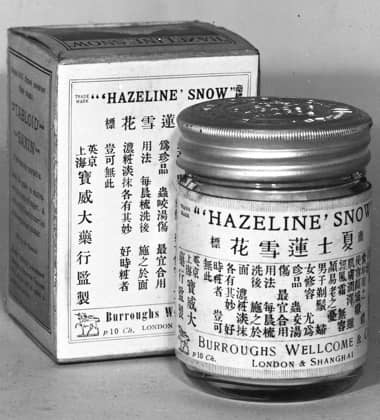
1934 Hazeline Snow in Chinese packaging.
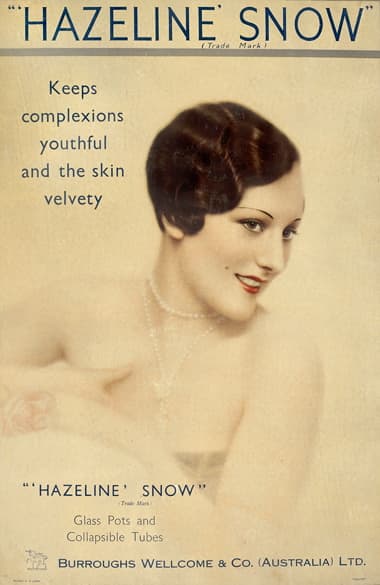
1934 Hazeline Snow (Australia).
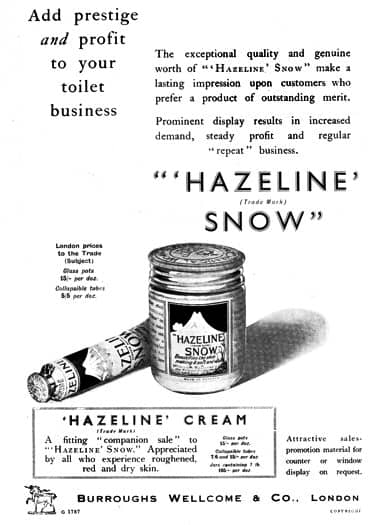
1934 Trade advertisement for Hazeline Snow and Hazeline cream.
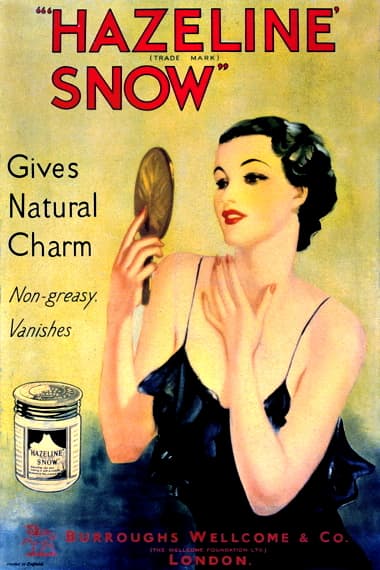
1937 Hazeline Snow.
